FROM the pages of the March 1934 number of Sky Fighters:
Editor’s Note: We feel that this 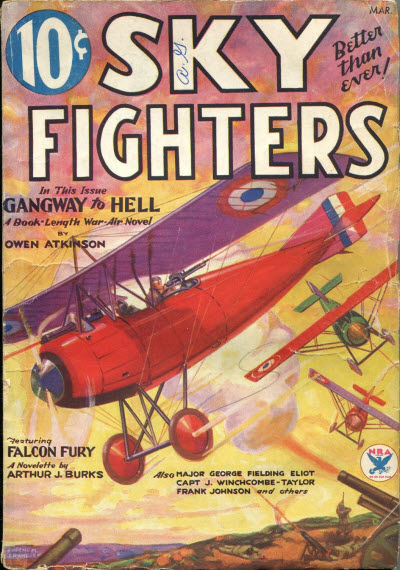 magazine has been exceedingly fortunate in securing Lt. Edward McCrae to conduct a technical department each month. It is Lt. Mcrae’s idea to tell us the underlying principles and facts concerning expressions and ideas of air-war terminology. Each month he will enlarge upon some particular statement in the stories of this magazine. Lt. MaCrae is qualified for this work, not only because he was a war pilot, but also because he is the editor of this fine magazine.
magazine has been exceedingly fortunate in securing Lt. Edward McCrae to conduct a technical department each month. It is Lt. Mcrae’s idea to tell us the underlying principles and facts concerning expressions and ideas of air-war terminology. Each month he will enlarge upon some particular statement in the stories of this magazine. Lt. MaCrae is qualified for this work, not only because he was a war pilot, but also because he is the editor of this fine magazine.
Aerial Photography
by Lt. Edward McCrae (Sky Fighters, March 1934)
NOW if you two sad-eyed rum-dums can hold your heads up long enough to listen, I want to smack you in the face with a question. No? Well, you’re gonna get the question anyway. Suppose you flew over some of the enemy’s territory yesterday and got acquainted with it till you could call it by its first name. And then you came along over the same ground today—I mean a mile or so over—and—stop interrupting—and today you saw a lot of trees that must have taken forty years to grow—and suppose those trees weren’t there yesterday?
What’s the Answer?
Well, you sleepy-eyed buzzards, to call you a polite name, you’d be seeing something that was mighty interesting to general headquarters. You’d probably fly over again Saturday afternoon and instead of seeing the trees you’d see nothing but a lot of shell holes.
The answer?
Aerial photography! One of the most important branches of the flying service.
Put a couple of ten-gallon funnels in your ears to let the wisdom run in to a place where there’s plenty of room for it, and I’ll tell you about a trip made by one of the war’s outstanding heroes, who must be nameless on account of his becoming modesty. We got orders from G.H.Q., which is the title of the brass hats hired to do nothing but think up crazy ideas to make flyers uncomfortable. They wanted photographs of what we will call sector D-7, because that was the way it was identified on the big maps. So naturally they called on me to do it.
I Get a Camera
I was playing stable boy and jockey to a Sopwith. The so-called experts from the photography shack brought me out a camera—open your eyes long enough to look at the picture in Figure 1, will you? Okay, go back to sleep. I fitted the camera into the conical—not comical—slot it goes into and we climbed to about seven thousand feet, not going any higher because the light was bad.

Now, the sector we wanted to catch had a road bisecting it. I had another pilot at the stick so I could operate the camera (because the brass hats wanted to be sure the pictures were good!) So I had told my pilot to start and follow the road to the end of the sector, then come back parallel to it on the left, then go forward to the left of that, and back again to the left of that. Just like a man plowing a field.
It’s Foolproof
The camera is claimed to be foolproof. Not that that mattered to me, understand. You’ve got eighteen plates stacked in a changing box over the shutter. You have a loading handle which you slide backward and forward and the first plate falls into position. When you get over the spot you’re ready to shoot you pull a string. You tell the spot by looking at the previous pictures that were taken of the same ground.
When the string is pulled you’ve got a picture of a big area over a mile below. You yank the loading handle and the camera ejects the exposed plate into a changing-box underneath and the number two plate falls into place in the camera. You keep up this simple operation until you’ve shot all your plates.
Did I say simple—you simpletons? You’ve got plenty to do and to worry about. You have to get your positions, figure out when the ship is flying dead level so you won’t shoot a picture off to the right or left, and you’ve got to figure out the proper intervals of time between shots, so you’ll cover all the territory. Open your eyes well and look at Figure 2 to see what the ground looks like.

And then another small item might be mentioned in passing. The antiaircraft guns. Those little darlings just dearly love to pop away at you as soon as you are over the German lines.
And here’s the fun in the game of “picture, picture, who’ll get the picture.†You can’t afford to dodge their cute little bursting shells because you have to take all your pictures in a straight line and from the same altitude or they will be worthless. You have to fly straight, count five, pull the string, jerk the reloading lever, count five, pull the string, jerk the reloading lever—and you keep repeating that until I tell you to stop.
Overlapping Pictures
You have to make the pictures so they will overlap on all sides, like they do in Figure 3, then the brass hats put them together to form one big picture of the sector. So, thickheads, if you shot one here and another there, it would be as hard to match them up as a jig-saw puzzle.
Anyway, we get the five pictures on the first spurt across the line, nose her up and over into an Immelmann turn and start on the return voyage. But now we’re having the wind on our tail and are hitting it off at a hundred and fifty miles an hour. And so I’ve got to pull the string, count two, yank the lever, pull the string, and so forth. You can get it through your thick skulls, can’t you, that since we’re going faster, we have to work the camera faster to get the same number of pictures per mile? Good!

We Get a Break
But we get a break on this first return trip. We make a harder target for the archies who are sure burning up a lot of Herr Kaiser’s ammunition. Shells are bursting all around us. Not that I care, but I feel sorry for the pilot up in front. I bet he’s scared to death.
Whew! We’re back over our own lines. That’s great, except we’ve got to make another round trip to get the sector covered.
We act like we’re headed for home and the archies decide to call it a day and go home for a glass of beer. We’ve fooled ’em.
Then They Get Mad
Now we whip around and start plowing another furrow of pictures. The archie crew look kind of cheap at being fooled. Then they get mad and red in the face and call us a lot of schwein and ach du leibers and start sending us bursting greetings by the tons.
Well, I don’t like to talk about myself in too much detail, so I’ll just say that we accomplished the impossible and got back from that round trip.
The O.C. meets us as we settle gently to earth on one wheel and one propeller blade and rushes the camera to the dark room, where the experts develop the plates in about twenty minutes.
Now for Those Trees
Now if you can remember as far back as the beginning of this serious and highly technical discourse you might get some idea of what I meant. About those forty-year-old trees that grew up from acorns overnight, like Jack and the beanstalk.
Yes, they were camouflage to cover big guns that were being moved into place in the sector, but you’re both liars. You didn’t know that until I told you.
I have wasted my time giving you just one of many uses for aerial photography. Thousands of photographs were taken every day, and they enabled the generals to be prepared for attacks that otherwise would have surprised them. They gave exact information as to distance to strategic targets, and told when those targets, ammunition dumps, rail heads and concentration points were effectively incapacitated, as the big-word artists would have it.
Formed a War History
They formed a complete history of the war. They were studied and argued over, they solved impenetrable mysteries. There were thousands of pictures of every conceivable angle of the war. They’ll be valuable in the next war—which is headed this way faster’n a jack rabbit.
So now you two Rip Van Winkles can wake up long enough to try to make up your minds whether you want to shoot the enemy with a Kodak or a machine-gun during the next war. The photographic branch has gone forward just like the rest of aviation in the recent years and it’s going to be even more important.
Now you stay awake a while, while I sleep.
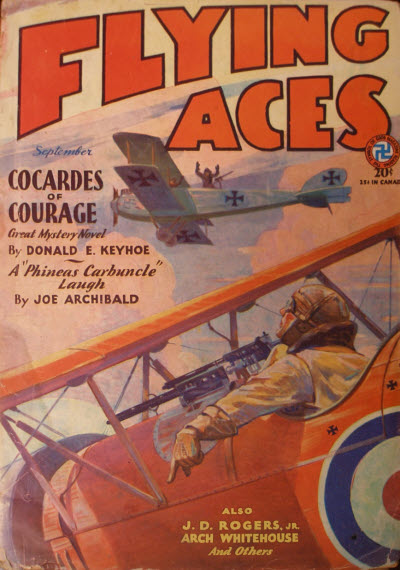 That sound can only mean one thing—that Bachelor of Artifice, Knight of Calamity and an alumnus of Doctor Merlin’s Camelot College for Conjurors is back to vex not only the Germans, but the Americans—the Ninth Pursuit Squadron in particular—as well. Yes it’s the marvel from Boonetown, Iowa himself—Lieutenant Phineas Pinkham!
That sound can only mean one thing—that Bachelor of Artifice, Knight of Calamity and an alumnus of Doctor Merlin’s Camelot College for Conjurors is back to vex not only the Germans, but the Americans—the Ninth Pursuit Squadron in particular—as well. Yes it’s the marvel from Boonetown, Iowa himself—Lieutenant Phineas Pinkham! 




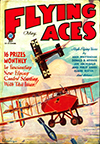

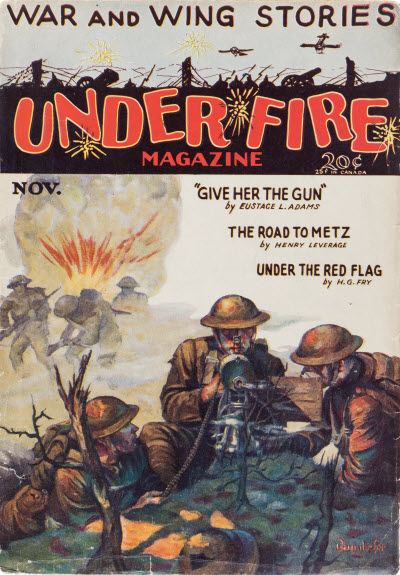 a story from the prolific pen of Eustace L. Adams. Born in 1891, Adams was an editor and author who served in the American Ambulance Service and the US Naval Service during The Great War. His aviation themed stories started appearing in 1928 in the various war and aviation pulps—Air Trails, Flying Aces, War Stories, Wings, War Birds, Sky Birds, Under Fire, Air Stories and Argosy. He is probably best remembered for the dozen or so airplane boys adventure books he wrote for the Andy Lane series.
a story from the prolific pen of Eustace L. Adams. Born in 1891, Adams was an editor and author who served in the American Ambulance Service and the US Naval Service during The Great War. His aviation themed stories started appearing in 1928 in the various war and aviation pulps—Air Trails, Flying Aces, War Stories, Wings, War Birds, Sky Birds, Under Fire, Air Stories and Argosy. He is probably best remembered for the dozen or so airplane boys adventure books he wrote for the Andy Lane series.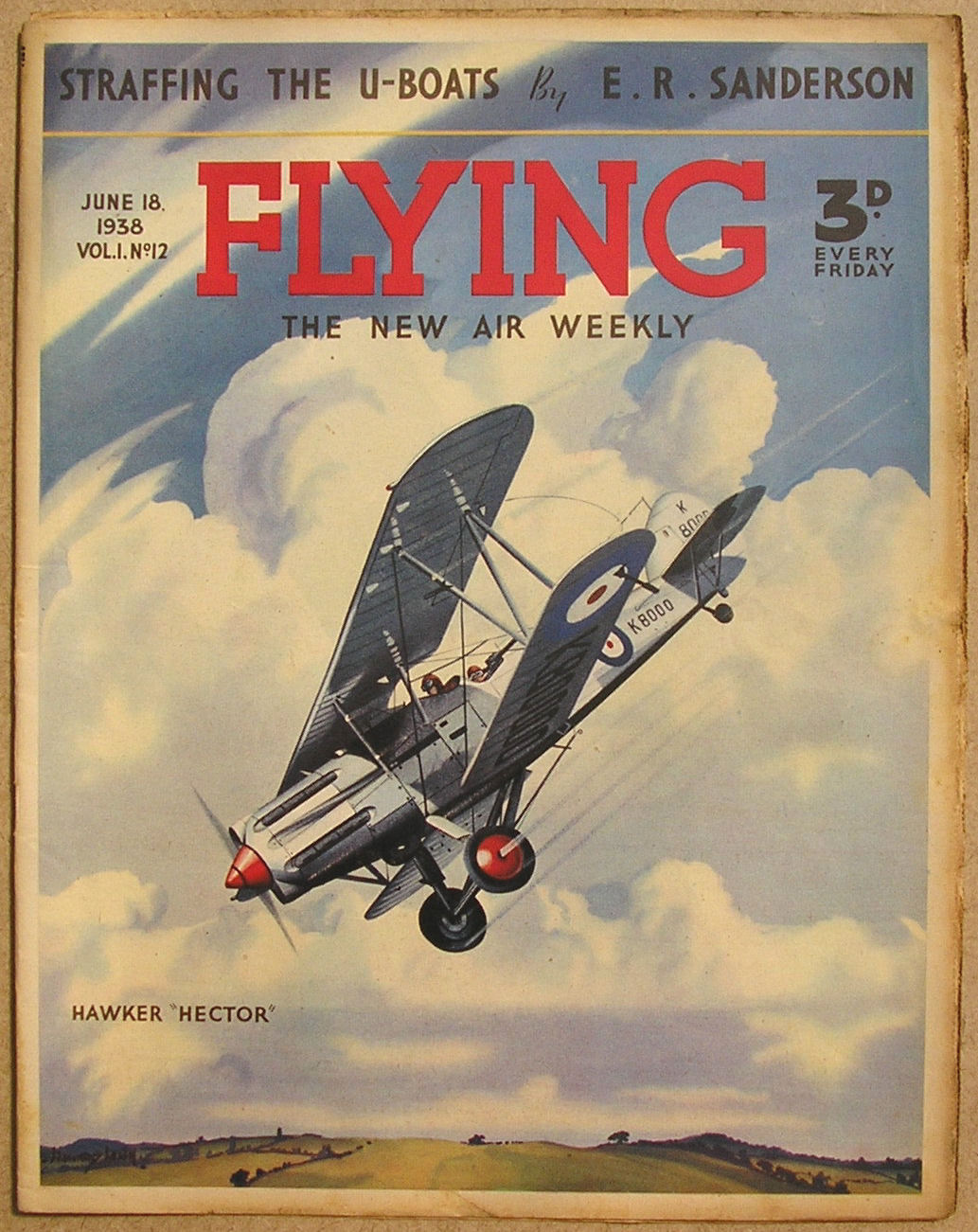 weekly paper of all things aviation, started up in England in 1938, amongst the articles and stories and photo features was an illustrative feature called “Heroes of the Air.” It was a full page illustration by S. Drigin of the events surrounding how the pictured Ace got their Victoria Cross along with a brief explanatory note.
weekly paper of all things aviation, started up in England in 1938, amongst the articles and stories and photo features was an illustrative feature called “Heroes of the Air.” It was a full page illustration by S. Drigin of the events surrounding how the pictured Ace got their Victoria Cross along with a brief explanatory note. 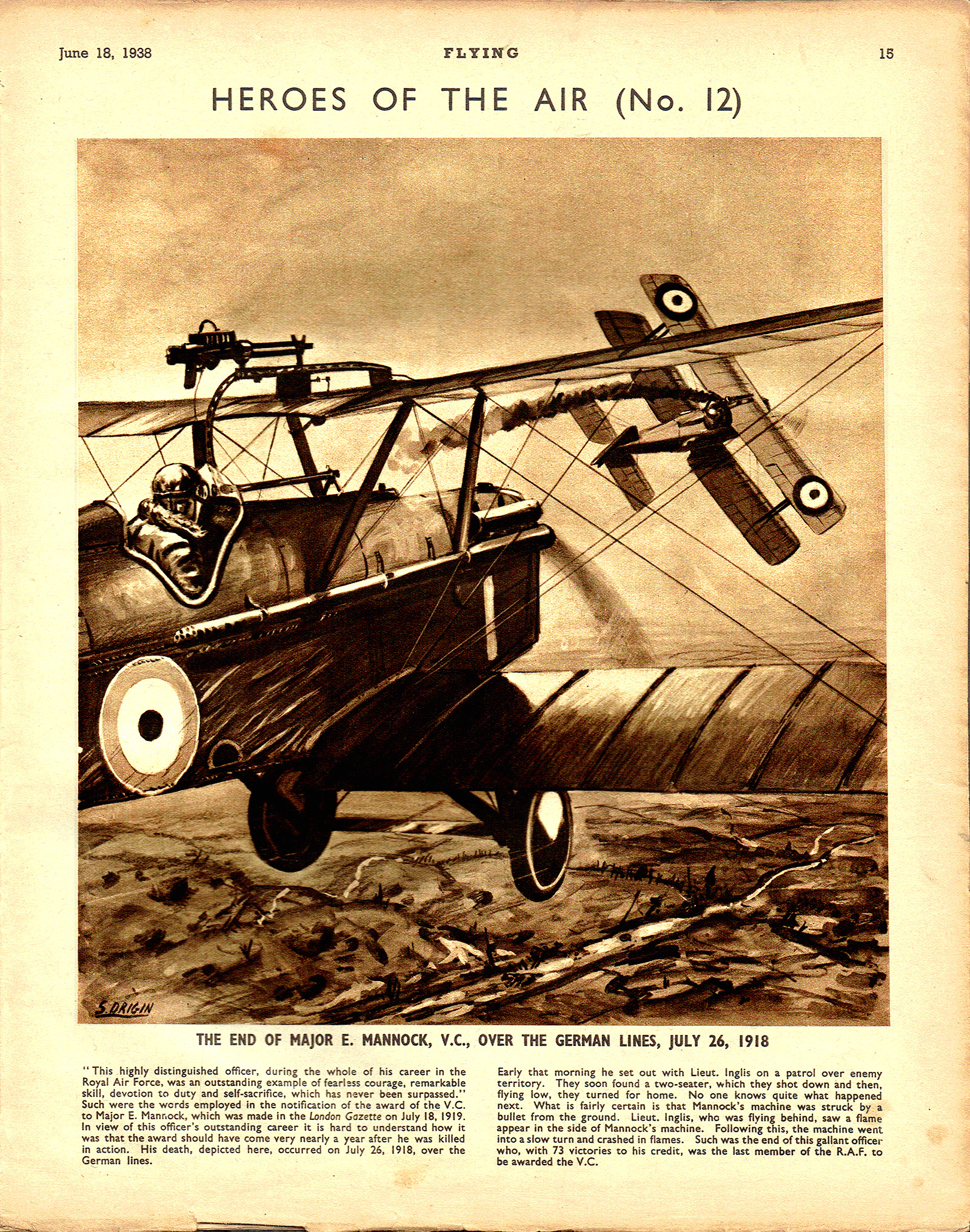
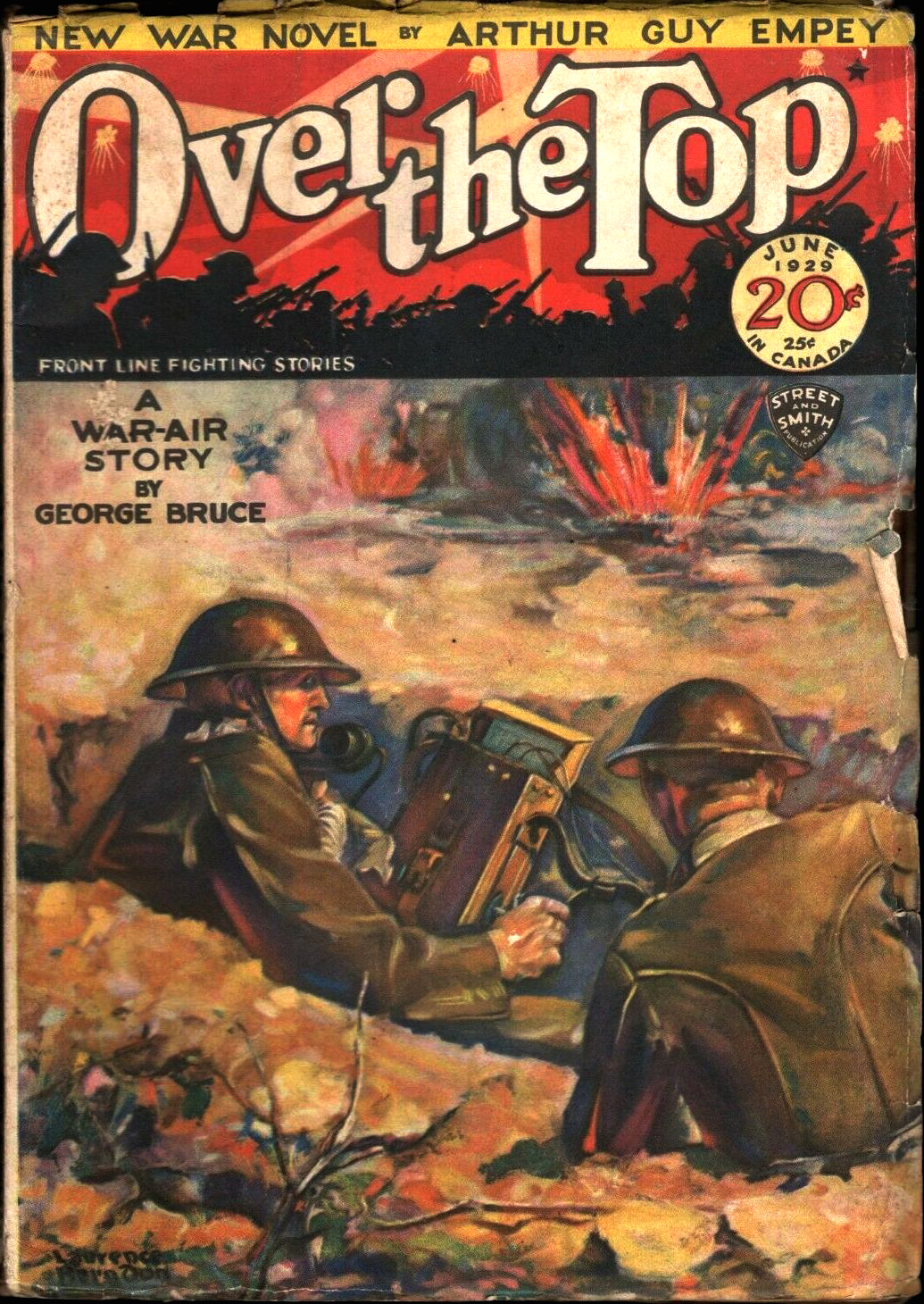 a story from
a story from  magazine has been exceedingly fortunate in securing Lt. Edward McCrae to conduct a technical department each month. It is Lt. Mcrae’s idea to tell us the underlying principles and facts concerning expressions and ideas of air-war terminology. Each month he will enlarge upon some particular statement in the stories of this magazine. Lt. MaCrae is qualified for this work, not only because he was a war pilot, but also because he is the editor of this fine magazine.
magazine has been exceedingly fortunate in securing Lt. Edward McCrae to conduct a technical department each month. It is Lt. Mcrae’s idea to tell us the underlying principles and facts concerning expressions and ideas of air-war terminology. Each month he will enlarge upon some particular statement in the stories of this magazine. Lt. MaCrae is qualified for this work, not only because he was a war pilot, but also because he is the editor of this fine magazine.


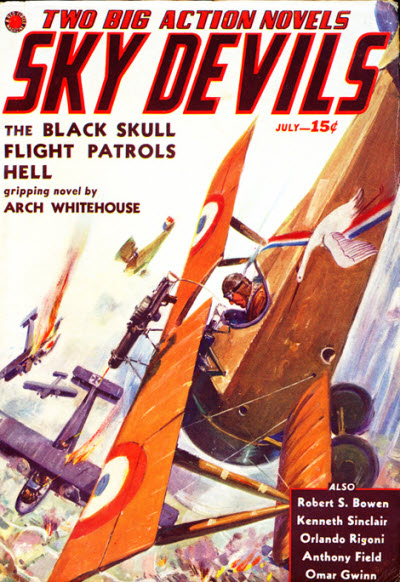 from the prolific pen of Robert Sidney Bowen. Bowen was a war pilot of the Royal Air Force, as well as the editor of one of the foremost technical journals of aviation in addition to penning hundreds of action-packed stories for the pulps.
from the prolific pen of Robert Sidney Bowen. Bowen was a war pilot of the Royal Air Force, as well as the editor of one of the foremost technical journals of aviation in addition to penning hundreds of action-packed stories for the pulps.